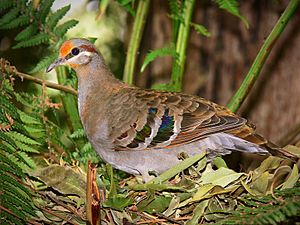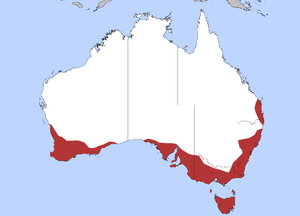Brush bronzewing facts for kids
The brush bronzewing (Phaps elegans) is a type of bird that belongs to the pigeon and dove family, called Columbidae. You can only find this bird in Australia.
Quick facts for kids Brush bronzewing |
|
|---|---|
 |
|
| Conservation status | |
| Scientific classification | |
| Genus: |
Phaps
|
| Species: |
elegans
|
 |
|
| Distribution of the brush bronzewing | |
Contents
What is a Brush Bronzewing?
The brush bronzewing is part of a big bird family called Columbidae, which includes about 310 different kinds of pigeons and doves. This bird was first officially described by a scientist named C. J. Temminck in 1810.
How to Spot a Brush Bronzewing
Brush bronzewings are similar to their relatives, the common bronzewing, but they look a bit shorter and stronger.
These birds are fairly small, growing to about 25 to 33 cm long. Male and female brush bronzewings look a little different, which is called Sexual dimorphism. Both sexes have dark olive-brown feathers on their backs. Their necks and shoulders are a rich chestnut color, and their undersides are blue-grey.
The brush bronzewing gets its name from the shiny, rainbow-like patches of blue and green on the inner feathers of each wing. These patches shimmer like bronze!
Where Do They Live?
The brush bronzewing lives only in Australia. You can find them in the southwest and southeast parts of the mainland. They live in states like Queensland, New South Wales, Victoria, South Australia, and Western Australia, as well as on the island of Tasmania.
These birds love places with thick bushes and plants, like coastal heathland or sclerophyll forests. They also live in woodlands and some mallee areas. They prefer habitats with lots of dense shrubs, such as Banksia, Acacia, Melaleuca, or Leptospermum plants. These thick plants help the cautious birds hide and stay safe.
Brush Bronzewing Behavior
What Do They Eat?
Brush bronzewings mostly eat seeds, berries, and small insects. They search for their food on the ground. Like many birds that eat seeds, called granivores, they swallow small pieces of grit or pebbles. These tiny stones help their gizzard (a part of their stomach) grind up the seeds.
These birds usually move around locally to find food and good places to live. Unlike the common bronzewing, brush bronzewings usually look for food alone or in pairs, not in big groups. They also drink water at dawn or dusk, just like common bronzewings. They are very careful, landing a short distance from a watering hole before slowly approaching it.
How Do They Raise Their Young?
Brush bronzewings have a special way of attracting a mate, similar to the common bronzewing. The male bird will bow, and they make a low, repeated 'hoop' or 'whoo' sound.
They mainly breed between September and January, but you might see eggs and young birds at any time of the year. When they hatch, the young birds are quite helpless. They need their parents to keep them warm, feed them, and take care of them a lot.
A female brush bronzewing usually lays two eggs. The parents will sit on the eggs for about 17 days until they hatch. The young birds will stay in the nest for about 16 to 20 days before they are ready to fly. After the young birds can take care of themselves, the adult pair might start breeding again in about 3 to 4 weeks.
Because these birds are very shy and careful, they will quickly fly away from their nests if they feel threatened. This might be why not many of their nests are successful. One study found that out of 29 eggs in 15 nests, only seven hatched, and only three of those young birds survived to fly away.
Do They Migrate?
Brush bronzewings usually stay in their local areas. They don't travel long distances or have big migrations. In one study from 1967, a bird was found only 25 km from where it was first tagged.
These birds are rarely seen flying in large groups. They prefer to move alone, in pairs, or in small family groups. The biggest group ever seen together was eight birds.
Protecting the Brush Bronzewing
The brush bronzewing is listed as a species of Least Concern on the IUCN Red List. This means that experts believe their populations are stable and not currently at high risk of disappearing. BirdLife Australia also thinks their numbers are secure in all the states where they live.
However, like many other birds that live on the ground, brush bronzewings face dangers from animals brought to Australia, such as cats and foxes. Interestingly, these birds might have a special defense. They sometimes eat Gastrolobium plants, which can be poisonous to some animals. This might help protect them from non-native predators, especially in southwest Western Australia.
See also
 In Spanish: Paloma bronce elegante para niños
In Spanish: Paloma bronce elegante para niños


